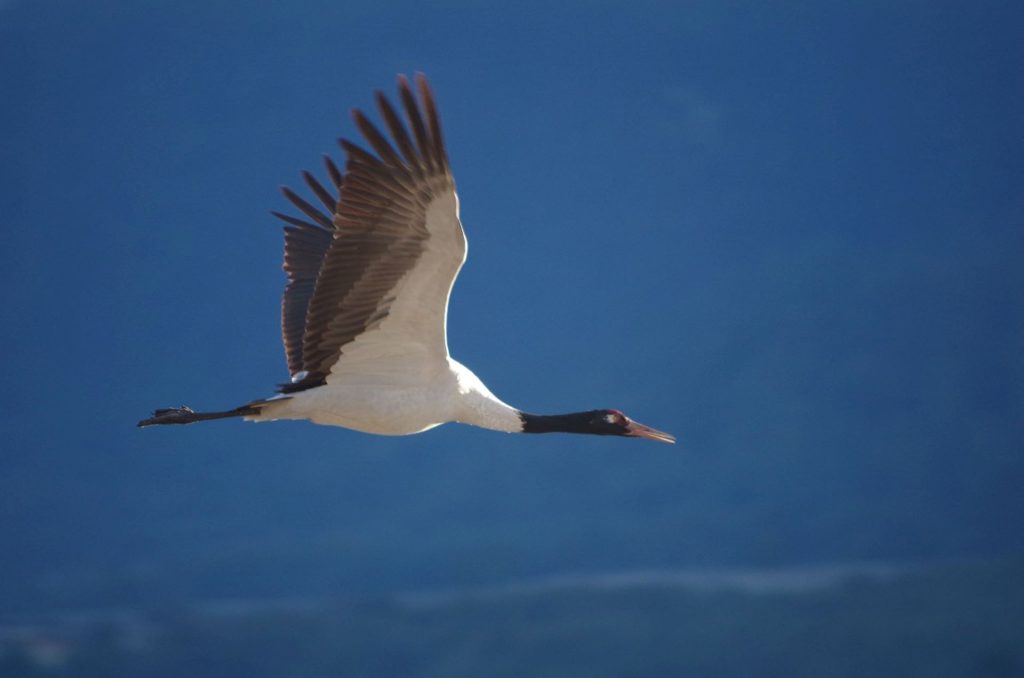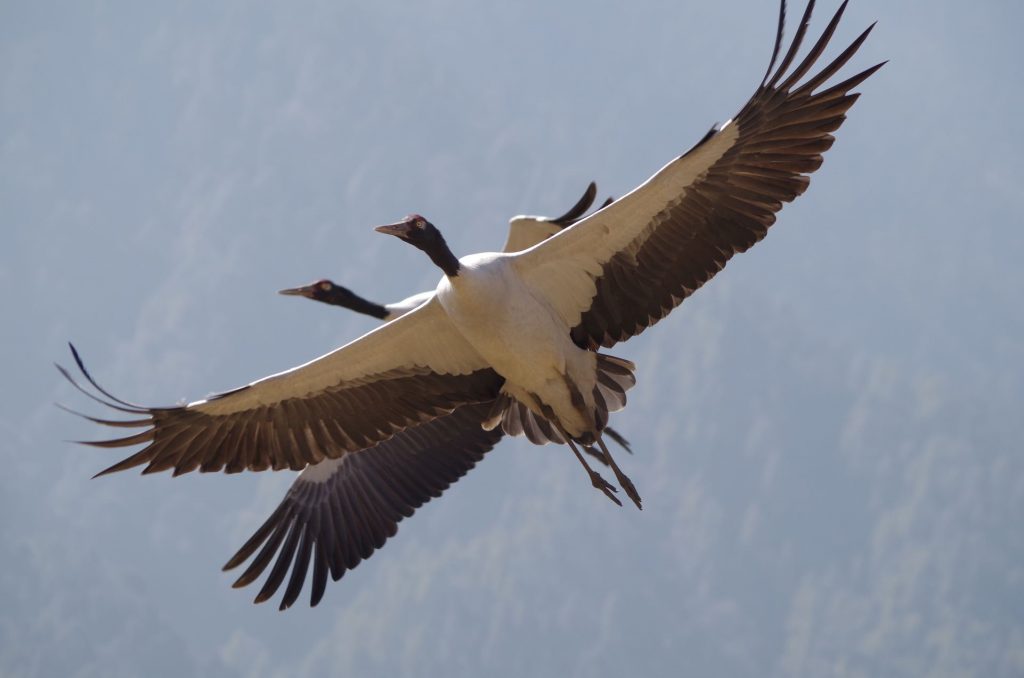Scientific name: Grus nigricollis
Local name: Thrung Thrung Karmo (native language)
Status: Near Threatened, IUCN Redlist category of threatened species
Global Population: 17,389 – 17610 individuals
Diet: Plant roots and tubers, insects, snails, shrimp, fish, frogs, lizards, voles and waste/leftover grain from harvest fields
Habitat: Wetlands and upland agricultural fields
Global Distribution Range: Bhutan, China and India
Wintering sites in Bhutan: Bumthang (Chokhhor, Chumey and Tang) Lhuntse (Dungkar and Tangmachu) Trashiyangtse (Bomdeling and Yangtse) Wangduephodrang (Phobjikha and Khotokha)
In 1987, under the Royal Command of His Majesty the Fourth Druk Gyalpo Jigme Singye Wangchuck, the RSPN was established with the solitary purpose to monitor Black-necked Cranes and manage their habitats. Gradually, RSPN’s efforts have been strengthened towards habitat improvement, enhancing community support, and research. In recent years, the conservation measures to save the BNC have been further enhanced through the establishment of local/community conservation groups, involvement of stakeholders, and implementation of conservation projects in managing the overall landscape of BNC habitat. Through the concerted efforts of partners, stakeholders and donors across the range countries and beyond, much of the important sites of the Black-necked Cranes have been identified and protected. Subsequently, the population is observed to be increasing and thus an upgradation from Vulnerable to Near Threatened in the IUCN Redlist category of threatened species.
In particular, RSPN has been instrumental in the conservation of wetlands and the cranes in Phobjikha valley, which is the largest wetland and the largest habitat of the cranes in Bhutan. One such significant conservation initiative is the institution of the annual Black-necked Crane Festival, which was initiated in 1998 mainly to educate locals and visitors on conservation of cranes. Today the festival attracts several hundreds of international tourists and thousands of Bhutanese.
Black-necked Cranes are protected throughout Bhutan and listed under Schedule I as a protected bird species, both in the Forest and Nature Conservation Act of Bhutan, 1995 (RGoB, 1995) and the Forest and Nature Conservation Rules of Bhutan, 2017 (DoFPS, 2017). Recognizing the importance of the habitat for the wintering cranes, the Royal Government of Bhutan (RGoB) designated Phobjikha valley as an important Conservation Area in 1999, with RSPN as the focal agency for management.
These Cranes are revered as holy birds and messengers from heaven due to their magnificence, monogamous nature, and their longevity. The birds have inspired numerous folk songs and folktales.Ecologically, they are the ambassadors representing the pristine environment, wetland, and the healthy agricultural practices. The presence of these birds indicates a sound and pristine environment; the wetland and agricultural ecosystem that the birds depend on. Cranes forage in the post-harvest farmlands, feeding on waste grains and insects, while they use the wetlands for roosting safely at night. Economically, local farmers benefit from the presence of the birds in their valley through the hosting of visitors from across the globe. RSPN is focused on maintaining a viable wintering population of BNCs in Bhutan through improved habitat, enhanced community support, and increased knowledge base.However, with changing perceptions on conservation of wetlands and rapid economic development across the habitats, BNC faces various threats posed by both anthropogenic and natural forces.



Changes in climate conditions can alter the species composition, structure, dynamics and ecology of the wintering habitats of the BNC. Changes in annual precipitation and precipitation patterns can affect the ground water level of the wetlands in the long term, which has a significant impact on the soil conditions, species composition, structure and functioning of these ecosystems. The occurrence of extreme climate conditions poses a higher risk of habitat degradation or destruction by natural disasters.
In Phobjikha, annual mortality in the crane population by predation is around 2 to 3%. The main predators identified in the wintering sites are the common leopard (Panthera pardus) and stray dogs (Canis lupus familiars). While predation by common leopards is a natural threat, predation by stray dogs leads to an increased mortality rate, especially in Bumthang and Khotokha. Other potential predators are red foxes (Vulpes vulpes) and jackals (Canis aureus) (Choki et al, 2011).
In the Phobjikha valley, RSPN identified an opportunity to benefit both cranes and humans by promoting developmental activities that aided conservation. The program mainly focused on conserving the crane’s winter habitat while economically empowering the local community through promoting sustainable livelihood approaches. Some of its programs include community-based sustainable tourism, community-based solid waste management, environment and health, alternative energy, capacity development, women and energy, water and energy and community forest development. Research components include, transboundary migratory study, habitat study, annual population monitoring and rehabilitation of roosting areas.
BNC spends five months in Bhutan, spread across the valleys of four districts; Wangdue Phodrang in the west-central, Bumthang in the central, and Lhuentse and Trashiyangtse in the east. Records with RSPN since 1987 show an increasing trend in the wintering population (from 370 in 1987 to 599 individuals in 2022). The valleys of Phobjikha in Wangdue Phodrang and Bumdeling in Trashiyangtse are the two major wintering habitats, of which, Phobjikha hosts the largest population in the country. However, some of the historic habitats like Paro, Bajo, Punakha and some areas of Bumthang valley no longer hosts BNC due to habitat loss by developmental activities.
Black-necked Crane Education Centre at Gangtey – Phobjikha, Wangduephodrang plays a crucial role in enhancing awareness and knowledge on the cranes, ecotourism programs in the valley, local vegetation, flora and fauna and overall the community’s culture.
You can now be apart of our conservation initiatives and make a difference!
Copyright © 2025 RSPN All Rights Reserved